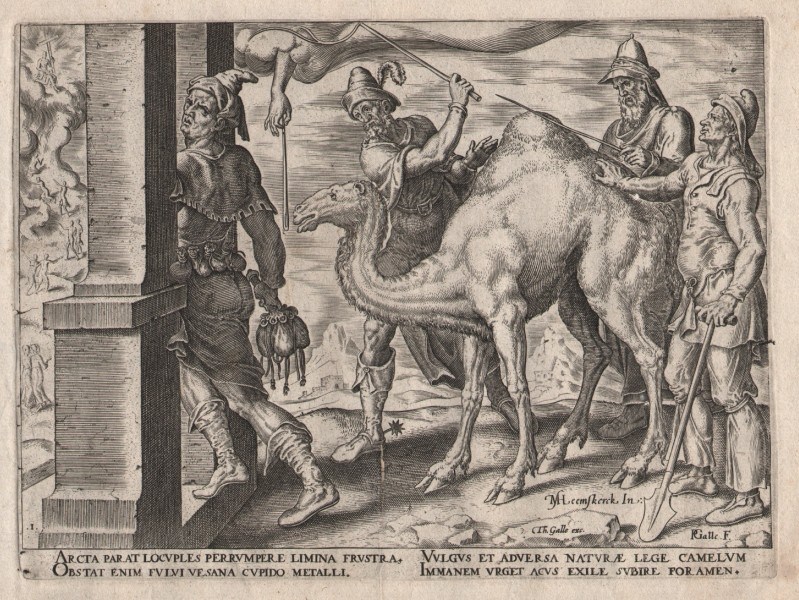Not only those familiar with the New Testament will know the expression “Camel through the eye of a needle.” This phrase is attributed to Jesus, Matthew 19:23-24 (cf. Mark 10:25; Luke 18:25): “Then said Jesus unto his disciples, Verily I say unto you, That a rich man shall hardly enter into the kingdom of heaven. And again I say unto you, It is easier for a camel to go through the eye of a needle, than for a rich man to enter into the kingdom of God.”
This metaphor is of course quite powerful, irrespective of any questions about its eventual authenticity, although the exaggerated hyperbole paradoxically results in tragic irony, since a conventional camel could never pass through the eyelet of a normal needle. This would mean that it is unreservedly impossible for a rich person to enter heaven – perhaps appealing to liberation theologians, or those who ascribe to the social gospel and/or predetermination, yet nonetheless doubtlessly a contradictio in adjecto.
Since at least Clement of Alexandria (ca 150-215 AD), a solution to this conundrum has been proposed. If we assume that an early copyist (and the first Christians who copied New Testament texts were not trained professionals, for which they were often rebuked by their opponents such as Porphyry) mistakenly wrote κάμηλον (kamelon) “camel” instead of κάμιλον (kamilon) “rope, cable” (of a ship, of a net), then the aphorism might make more sense to “fishers of men.”
One problem, is that kamelon is only attested once in what survives of ancient Greek. Nonetheless, the notion of a rope or a cable, made by twisting together strands of hemp or some other such material is quite attractive, as by unravelling, disposing oneself of material possessions, it might just be possible to finally go through the needle’s eye, or enter heaven as it were.
This apophthegm is of course found in the Qur’an in 7:40: “Lo! they who deny Our revelations and scorn them, for them the gates of heaven will nor be opened not will they enter the Garden until the camel goeth through the needle’s eye (ḥattā yaliǧa lǧamalu). Thus do We requite the guilty.”
Obviously, this is borrowed, whether directly or indirectly need not concern us here, from the New Testament passages mentioned in the preceding, and thus tells us something about the history of the Qur’an – its obscurity precludes it being an independent composition.
Naturally, the same syllogistic concerns apply here as with its ultimate source. Interestingly enough, in traditions attributed to Ibn ʽAbbās (questions as to his doubtful historicity need not concern us here), and cited by some later exegetes, we find the suggestion that instead of ǧamal “camel” one should instead read ǧummal “thick nautical rope, anchor cable.”
The fact that this lexeme, like the Greek term mentioned in the preceding, has maritime semantics is noteworthy. It should be noted here that both Greek terms, scilicet, κάμηλον/ “camel” thus κάμιλον/ “rope cable” are Semitic loan-words, the former necessitates no explanation; the latter from a common Semitic root ḥbl (cf. e.g. Hebrew ḥeḇel, Arabic ḥabl).
This of course would seem to imply that not only the precept itself, but also this exegesis was borrowed from Christian traditions (in the widest sense of the word). Since the semantics of ḥbl denoting a (nautical) rope (rather surprising indeed, if we are to believe that the Qur’an originated in the Hejaz), along with the fact that ǧummal in this meaning is only really employed in Arabic in connexion with this Quranic verse (s., Lane, Lexicon, S. 461) one might ask whether a word was invented to fit the established exegetical tradition.
In old Arabic, such as is found in the oldest Quranic manuscripts, which are unpointed, ǧamal/camel/ جمل und ḥabl/rope,cable/ حبل are quite similar, حمل (j/ḥ/ḫ/ml), one can easily read this passage as ḥattā yaliǧa l-ḥablu “until the rope goeth through the needle’s eye.”
The fact that both the ropy semantics and the ǧīm were preserved, although a good Arabic alternative was available, demonstrates that the Ibn ʽAbbās tradition, that which shows the most familiarity with biblical materials, must be dependant on these, to which the neologism ǧummal testifies.
This is just another indication that the Qur’an and its early exegesis were rooted in the exegetical and hermeneutical culture of interpretation of the Bible, where occasionally something was lost in translation. We may yet ourselves be sooner able to pass through a needle’s eye before we are completely able to understand the convoluted language of the Qur’an.
Professor Dr. Robert M. Kerr studied Classics and Semitics largely in Vancouver, Tübingen and Leyden. He is currently director of the Inârah Institute, for research on Early Islamic History and the Qur’an in Saarbrücken (Germany).
The image shows the “Camel going through the eye of a needle,” a print by Maarten van Heemskerck, from his series, The Wretchedness of Wealth, from 1563.
